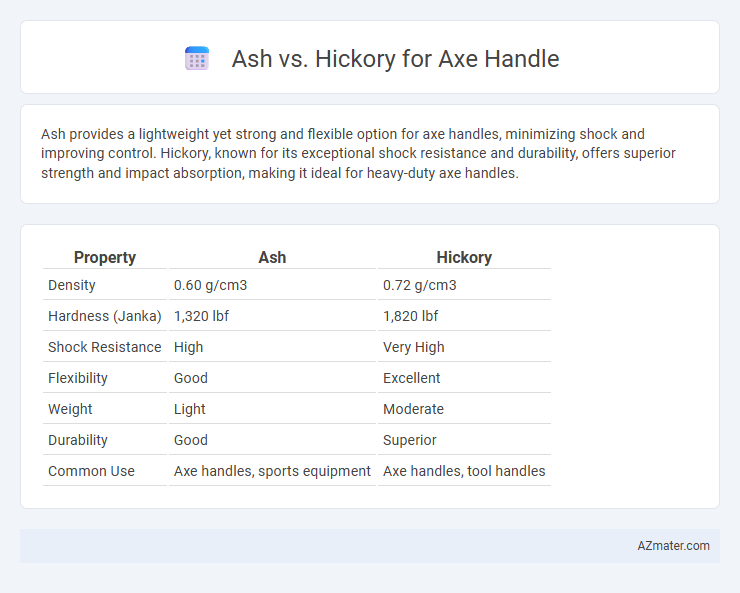Ash provides a lightweight yet strong and flexible option for axe handles, minimizing shock and improving control. Hickory, known for its exceptional shock resistance and durability, offers superior strength and impact absorption, making it ideal for heavy-duty axe handles.
Table of Comparison
| Property | Ash | Hickory |
|---|---|---|
| Density | 0.60 g/cm3 | 0.72 g/cm3 |
| Hardness (Janka) | 1,320 lbf | 1,820 lbf |
| Shock Resistance | High | Very High |
| Flexibility | Good | Excellent |
| Weight | Light | Moderate |
| Durability | Good | Superior |
| Common Use | Axe handles, sports equipment | Axe handles, tool handles |
Introduction: Choosing the Right Wood for Axe Handles
Ash and hickory are the top choices for axe handles due to their superior strength, shock absorption, and durability. Hickory boasts a high tensile strength near 12,000 psi and excellent flexibility, making it ideal for heavy-duty chopping and splitting tasks. Ash offers similar robustness with a slightly lower density, providing a lightweight yet resilient handle preferred for precision and control in various axe applications.
Key Characteristics of Ash and Hickory
Ash axe handles are known for their exceptional shock absorption and flexibility, making them ideal for reducing user fatigue during prolonged use. Hickory handles offer superior strength and durability, with a tight grain structure that resists splitting and withstands heavy impact. Both woods are popular choices for axe handles, but hickory typically provides better resilience in demanding chopping tasks.
Strength and Durability Comparison
Ash excels in shock absorption and offers lightweight strength, making it ideal for axe handles that require flexibility and durability under repetitive impacts. Hickory surpasses ash in overall toughness and resistance to wear, providing exceptional strength that withstands heavy chopping and sustained use. Both woods deliver reliable performance, but hickory's superior density and resilience make it the preferred choice for long-term durability in demanding conditions.
Shock Absorption: Which Wood Performs Better?
Ash offers superior shock absorption compared to hickory, making it a preferred choice for axe handles that reduce user fatigue during extended use. Hickory is known for its exceptional strength and durability but tends to transmit more vibration to the hand. Studies in tool handle materials consistently show ash's cellular structure provides better damping properties, enhancing comfort and control in chopping tasks.
Weight and Balance Considerations
Ash axe handles offer lightweight durability with excellent shock absorption, making them ideal for prolonged use and reducing user fatigue. Hickory handles provide a slightly heavier feel, delivering superior strength and balance that enhances control and precision during heavy chopping tasks. Choosing between ash and hickory depends on the desired balance between weight and handling performance, with ash favoring lighter weight and hickory excelling in stability and power.
Workability and Shaping Differences
Ash offers superior flexibility and shock absorption, making it easier to shape and less prone to splintering during axe handle crafting. Hickory, known for its exceptional strength and density, requires more effort to carve but provides greater durability and resistance to wear. The choice between ash and hickory hinges on balancing ease of workability with the desired toughness and longevity of the axe handle.
Availability and Cost Factors
Ash axe handles are widely available due to the tree's abundance in North America and Europe, making them more affordable and easier to source for manufacturers and consumers. Hickory, while slightly less common and primarily found in the eastern United States, tends to be more expensive due to its superior shock absorption and durability, which justify the higher price for professional or heavy-duty use. Cost factors also depend on the quality grade and treatment of the wood, with premium hickory handles often commanding a premium despite limited availability compared to ash.
Longevity and Maintenance Requirements
Ash axe handles offer excellent shock absorption and flexibility, contributing to their durability under heavy use, while requiring regular maintenance such as oiling to prevent drying and cracking. Hickory handles provide superior strength and resistance to wear, making them highly durable with less frequent upkeep needed to maintain their integrity. Choosing between ash and hickory hinges on balancing the need for flexibility and ease of maintenance against raw strength and longevity in demanding tasks.
Common Uses and Regional Preferences
Ash and hickory are premier choices for axe handles due to their exceptional strength and shock resistance, commonly used in forestry and woodworking across North America and Europe. Ash, favored in the Midwest and parts of Europe, offers a lighter feel and flexibility, ideal for precision tasks and prolonged use, while hickory, predominant in the Eastern United States, is renowned for its superior toughness and durability under heavy impact. Regional preferences align with task requirements: ash is preferred for lightweight applications such as carpentry, whereas hickory is chosen for demanding environments like logging and chopping.
Final Verdict: Ash vs Hickory for Your Axe Handle
Hickory offers superior shock absorption and durability, making it the preferred choice for heavy-duty axe handles used in felling and splitting tasks. Ash provides excellent flexibility and a lighter feel, suitable for users who prioritize control and swing speed. For most axe handle applications, hickory's strength and resilience ensure a longer lifespan and better performance under repeated impact.

Infographic: Ash vs Hickory for Axe Handle
 azmater.com
azmater.com